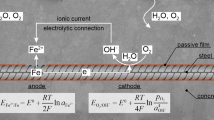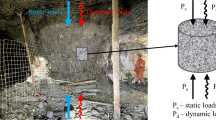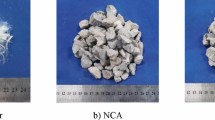Abstract
In order to obtains the damage characteristics of the polypropylene fiber mortar at medium loading rate (10–3 s–1). The damage evolution process (A, B and C stages) of mortar specimens with different polypropylene fiber content under uniaxial tension was studied by using the full waveform acoustic emission technology. The acoustic emission wavelet energy and spectrum characteristics of cd7 frequency band were analyzed. The results showed that with the increase of the polypropylene fiber content, the peak stress increases firstly and then decreases, the elastic modulus increases gradually, the peak frequency of cd7 frequency band decreases in the A and B stages but increases in the C stages. The peak frequency of cd7 frequency band down from 30–40 kHz to 20–30 kHz with the damage accumulation, the above characteristics can be used to identify the damage stages and damage mechanisms.
Similar content being viewed by others
References
Balaguru, P., Contribution of fibers to crack reduction of cement composites the initial and final setting period, ACI Mater. J., 1994, vol. 91, no. 27, pp. 280–288.
Mindess, S., Francis Young, J., and Darwin, D., Concrete, NJ (USA): Prentice Hall, 2003, 2nd ed.
Gao, D., Yan, D., and Li, X., Splitting strength of GGBFS concrete incorporating with steel fiber and polypropylene fiber after exposure to elevated temperatures, Fire Saf. J., 2012, vol. 54, pp. 67–73.
Bošnjak, J., Ožbolt, J., and Hahn, R., Permeability measurement on high strength concrete without and with polypropylene fibers at elevated temperatures using a new test setup, Cem. Concr. Res., 2013, vol. 53, pp. 104–111.
Qadi, A.L., Arabi, N.S., Mustapha, B., et al., Effect of polypropylene fibers on thermogravimetric properties of self-compacting concrete at elevated temperatures, Fire Mater., 2013, vol. 37, no. 3, pp. 177–186.
Grdic, Z.J., Curcic, G.A.T, Ristic, N.S., et al., Abrasion resistance of concrete micro-reinforced with polypropylene fibers, Constr. Build. Mater., 2012, vol. 27, no. 1, pp. 305–312.
Wu, Y., Sun, Q., Fang, H., et al., Surface-treated polypropylene fiber for reinforced repair mortar cementitious composites, Compos. Interfaces, 2014, vol. 21, no. 9, pp. 787–796.
Behfarnia, K. and Behravan, A., Application of high performance polypropylene fibers in concrete lining of water tunnels, Mater. & Des., 2014, vol. 55, pp. 274–279.
Segre, N., Tonella, E., and Joekes, I., Evaluation of the stability of polypropylene fibers in environments aggressive to cement-based materials, Cem. Concr. Res., 1998, vol. 28, no. 1, pp. 75–81.
Sideris, K.K., Manita, P., and Chaniotakis, E., Performance of thermally damaged fiber reinforced concretes, Constr. Build. Mater., 2009, vol. 23, no. 3, pp. 1232–1239.
Ouaar, A., Doghri., I., Delannay, L., et al., Micromechanics of the deformation and damage of steel fiber-reinforced concrete, Int. J. Damage Mech., 2007, vol. 16, no. 2, pp. 227–260.
Nia, A.A., Hedayatian, M., Nili, M., et al., An experimental and numerical study on how steel and polypropylene fibers affect the impact resistance in fiber-reinforced concrete, Int. J. Impact Eng., 2012, vol. 46, pp. 62–73.
Zhang, P. and Li, Q., Effect of polypropylene fiber on durability of concrete composite containing fly ash and silica fume, Compos. Part B: Eng., 2013, vol. 45, no. 1, pp. 1587–1594.
Zhang, Y.F., Liu, H., Chen, J.P., et al., Numerical Simulation on PPFRC with different contents, Appl. Mech. Mater., 2013, vol. 477–478, pp. 1019–1025.
Kakooei, S., Akil, H.M., Jamshidi, M., et al., The effects of polypropylene fibers on the properties of reinforced concrete structures, Constr. Build. Mater., 2012, vol. 27, no. 1, pp. 73–77.
Wang, Z.L., Liu, Y.S., and Shen, R.F., Stress–strain relationship of steel fiber-reinforced concrete under dynamic compression, Constr. Build. Mater., 2008, vol. 22, no. 5, pp. 811–819.
Li, W. and Xu, J., Mechanical properties of basalt fiber reinforced geopolymeric concrete under impact loading, Mater. Sci. Eng.: A, 2009, vol. 505, no. 1, pp. 178–186.
Luo, Y., Yu, C.X., and Gu, A.J., Study of the bond-slip behavior between rebar and concrete based on acoustic emission technology, J. Exp. Mech., 2011, vol. 26, no. 4, pp. 343–349.
Lai, Y.S., Xiong, Y., and Cheng, L.F., Frequency band energy characteristics of acoustic emission signals in damage process of concrete under uniaxial compression, J. Vib. Shock, 2014, vol. 33, no. 10, pp. 177–182.
Ni, Q.Q. and Iwamoto, M., Wavelet transform of acoustic emission signals in failure of model composites, Eng. Fract. Mech., 2002, vol. 69, no. 6, pp. 717–728.
Liu, J.W., Wu, X.Z., and Liu, X.X., Time-frequency characteristic and recognition technology of acoustic emission generated from rock brittle fracture, Appl. Mech. Mater., 2013, vol. 405, pp. 116–119.
Lu, Y. and Li, Z., Frequency characteristic analysis on acoustic emission of mortar using cement-based piezoelectric sensors, Smart Struct. Syst., 2011, vol. 8, no. 3, pp. 321–341.
Maji, A.K. and Sahu, R., Acoustic emissions from reinforced concrete, Exp. Mech., 1994, vol. 34, no. 4, pp. 379–388.
Farnam, Y., Geiker, M.R., Bentz, D., et al., Acoustic emission waveform characterization of crack origin and mode in fractured and ASR damaged concrete, Cem. Concr. Compos., 2015, vol. 60, pp. 135–145.
Wang, Y., Chen, S.J., Zhao, H.T., et al., Acoustic emission characteristics of interface between aggregate and mortar under shear loading, Russ. J. Nondestr. Test., 2015, vol. 51, no. 8, pp. 497–508.
Perov, D.V. and Rinkevich, A.B., Using wavelets for analyzing ultrasonic fields detected by a laser interferometer. Basic concepts of the wavelet analysis, Russ. J. Nondestr. Test., 2001, vol. 37, no. 12, pp. 879–888.
Perov, D.V., Rinkevich, A.B., and Smorodinskii, Ya.G., Wavelet filtering of signals from ultrasonic flaw detector, Russ. J. Nondestr. Test., 2002, vol. 38, no. 12, pp. 869–882.
Perov, D.V. and Rinkevich, A.B., Dyadic-wavelet-transform filtering of ultrasonic signals detected by a laser interferometer, Russ. J. Nondestr. Test., 2002, vol. 38, no. 4, pp. 288–305.
Perov, D.V., Rinkevich, A.B., Smorodinskii Ya.G., et al. Using wavelets for analyzing ultrasonic fields detected by a laser interferometer. Flaw detection and localization in an aluminum single-crystal, Russ. J. Nondestr. Test., 2001, vol. 37, no. 12, pp. 889–899.
Donoho, D.L. and Johnstone, I.M., Adapting to unknown smoothness via wavelet shrinkage, J. Am. Stat. Assoc., 1995, vol. 90, no. 432, pp. 1200–1224.
Donoho, D.L., Johnstone, I.M., Kerkyacharian, G., et al., Wavelet shrinkage: asymptopia?, in J. R. Stat. Soc. Ser. B (Methodol.), 1995, pp. 301–369.
Zhao, K., Deng, F., Jin, J.F, He, G.Q., and Liu, H.X., Wavelet analysis of Kaiser signal of rock acoustic emission and its application, Chin. J. Rock Mech. Eng., 2006, vol. 2, no. 2, pp. 3854–3588.
Liu, J. and Chen, G.X., Research on wavelet threshold de-noising methods for acoustic emission Signal, J. Shenyang Ligong Univ., 2015, vol. 34, no. 2, pp. 12–15.
Jia, L.L. and Wang, R.L., Research of AE characteristic of reinforced concrete structures, Sci. Technol. Eng., 2009, vol. 14, pp. 4234–4237.
Qi, G., Barhorst, A., Hashemi, J., et al., Discrete wavelet decomposition of acoustic emission signals from carbon-fiber-reinforced composites, Compos. Sci. Technol., 1997, vol. 57, no. 4, pp. 389–403.
Wang, Y., Chen, S.J., Liu, S.J, et al., Best wavelet basis for wavelet transforms in acoustic emission signals of concrete damage process, Russ. J. Nondestr. Test., 2016, vol. 52, no. 3, pp. 125–133.
Cai, M., Kaiser, P.K., Morioka, H., et al., FLAC/PFC coupled numerical simulation of AE in large-scale underground excavations, Int. J. Rock Mech. Min. Sci., 2007, vol. 44, no. 4, pp. 550–564.
Sagaidak, A.I. and Elizarov, S.V., Acoustic emission parameters correlated with fracture and deformation processes of concrete members, Constr. Build. Mater., 2007, vol. 21, no. 3, pp. 477–482.
Author information
Authors and Affiliations
Corresponding author
Additional information
The article is published in the original.
Rights and permissions
About this article
Cite this article
Yan, W., Jie, C.S., Lu, G. et al. Characterization of the Damage Process of Polypropylene Fiber Mortar at Medium Loading Rate by the Full Wave Acoustic Emission Technique. Russ J Nondestruct Test 54, 430–442 (2018). https://doi.org/10.1134/S1061830918060104
Received:
Published:
Issue Date:
DOI: https://doi.org/10.1134/S1061830918060104




